Woo Hoo!
😀 😯 😀
The two Parrot altimeters read 15960 and 15969 feet AGL at the instant of the apogee deployment charge, which was about 1.5 seconds early. After deployment, there are plenty of data points much higher than 16000 feet, but they're affected by the wind blowing into the av-bay holes. So for official purposes, based on the last valid measured data, let's call it 15965 feet. The existing Tripoli I record is 13,728.
More data and pictures later, but first some numbers for those who might be interested in checking this out in Rocksim:
The fins are 0.048 inches thick. The tube O.D. is 1.565" Both of these are the result of aggressively thin carbon fiber layups. The nosecone has a 9" long taper section, and a shape profile that is theoretically optimal for transsonic flow and a given diameter and volume. The total rocket length is 25.75", and there is only one airframe break, 11" from the nose. Last but not least, the motor aft closure is an officially-sanctioned flush closure from Rouse-tech, which has 1.500" OD, for 16% less base drag area than a standard knurled aft closure. The pre-flight mass was 1014 grams, and the post-flight mass is 679 grams. The boost was nice and straight.
My as-built Rocksim model predicts a 17,275 foot flight if the nosecone has these dimensions and a conical profile, and 14,463 for a Sears-Haack LD nosecone profile. I was expecting the actual performance to be between the two values, but closer to the conical case. In other words, given a straight boost, I was fully expecting 15k, and hoping for 16k-17k. I couldn't be happier with this result, despite the premature main deployment that required about 20 miles of hiking, a fortuitous similar flight with a better tracker setup, an aerial search, and a friendly landowner in order to get the rocket back.
I'm looking forward to flying it again, this time after more flight-like ground testing of the separation charge to make sure I don't get another premature main deployment. After I get some sleep I'll post some pictures and graphs.
Another couple of fun facts:
Right after burnout, the rocket was going 1440 mph (Just under Mach 2.0), and had 14 Gs of drag. The burn time for the I600 was just under 2.0 seconds, which is the same thing that Chris LaPanse measured a couple of years ago. So both the Rocksim and thrustcurve.org databases are substantially in error for this motor, unless both Chris and I got motors that are unusual in just the same way.
Lots more data (cross-posted at Rocketry Planet)
Here's more data from the new Featherweight Interface program:
Altitude and temperature, for the whole flight: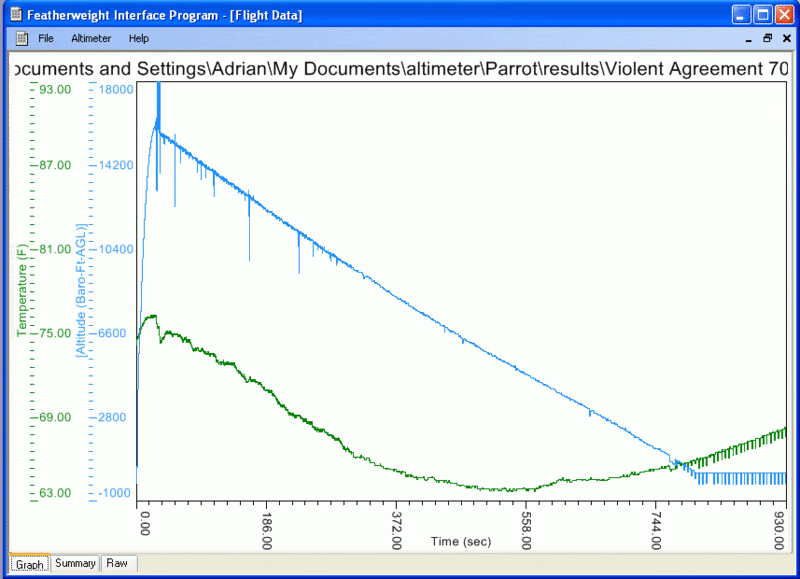
Velocity, accel, and altitude up through apogee deployment
Zoomed into the the motor burn: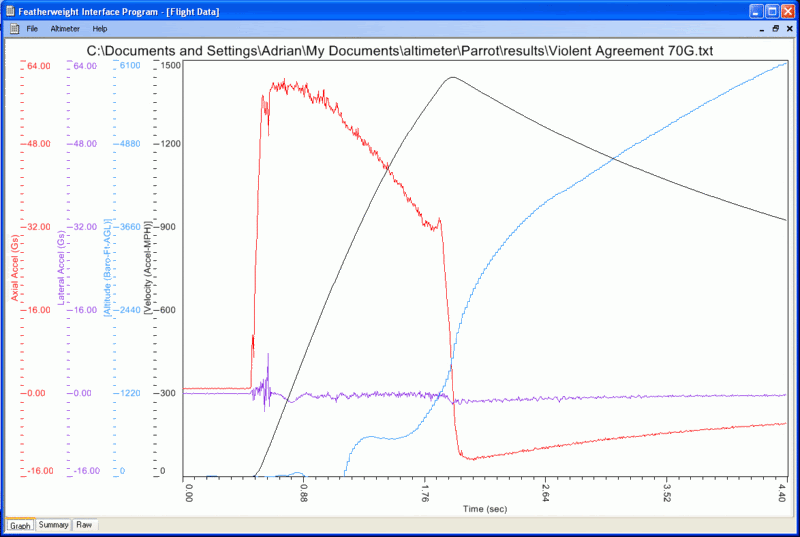
I did the following post-processing using the Excel template that's on the website. First, I adjust the accel offset, scale factor, and time factor so that the integrated accel calculated altitude matches the baro-based altitude (I leave the baro data alone):
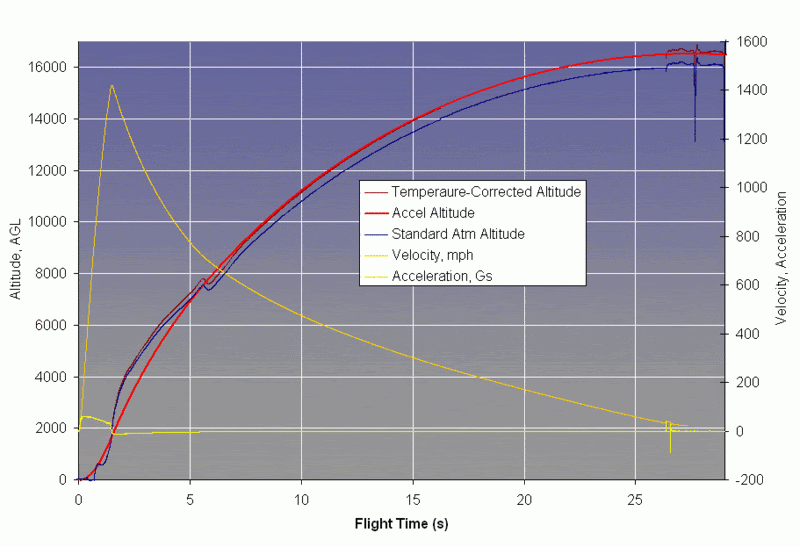
This gives me a set of accelerometer data that is consistent with the baro data. Here's the residual error between the two. Note how there is a little step change near 16 seconds. I believe that is when the delay burned through, equalizing the pressure between the motor and the rest of the rocket. Good thing I was using electronic ejection! It was still going up at 250 mph when the charge burned through.
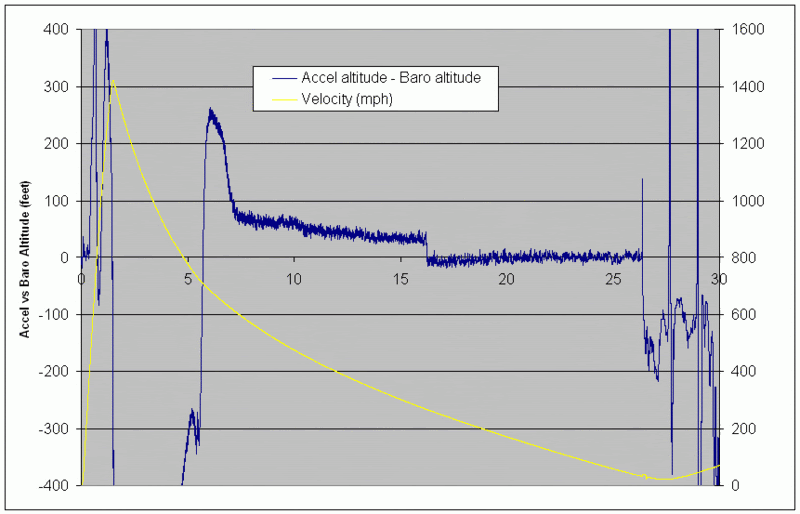
Now with good accel data, there's all kinds of things you can calculate. In particular, I'm happy with how the Cd vs. velocity came out: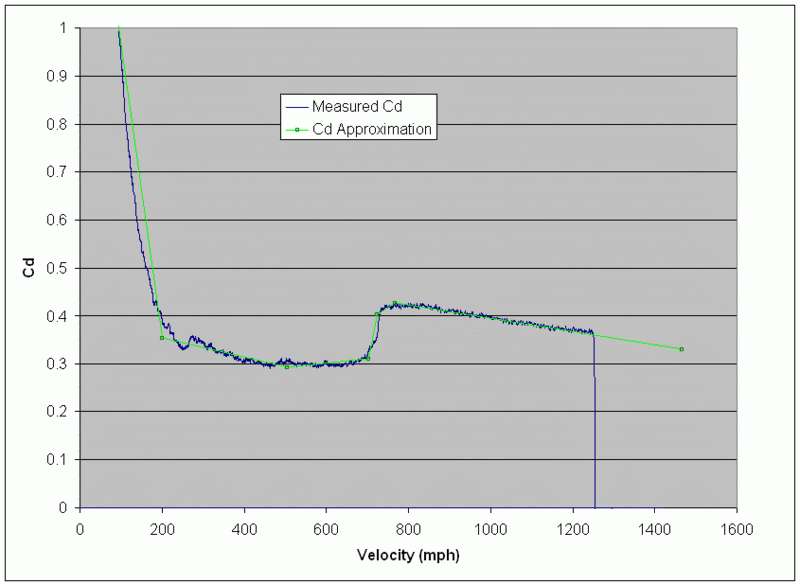
Compare that to the Cd vs. velocity data I got for conical and ogive-ish rockets last summer:
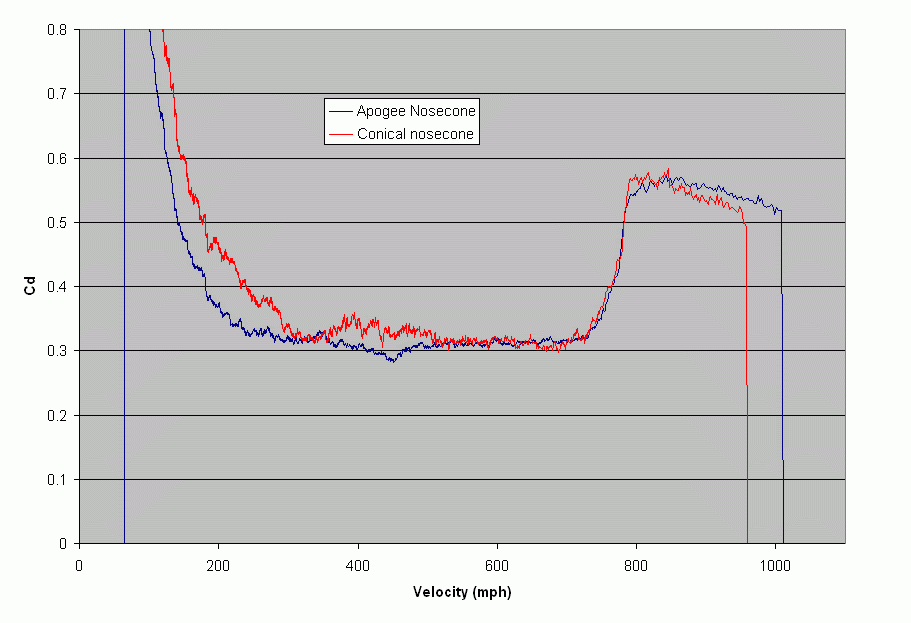
The supersonic penalty is only half what it was for either the conical or Apogee nosecones. Sweet.
Then I can take the Cd vs. velocity data that I measured after burnout, and use that to see what the aero drag was during the burn, and subtract that off from the measured force to get a nice thrust vs. time curve for this flight:
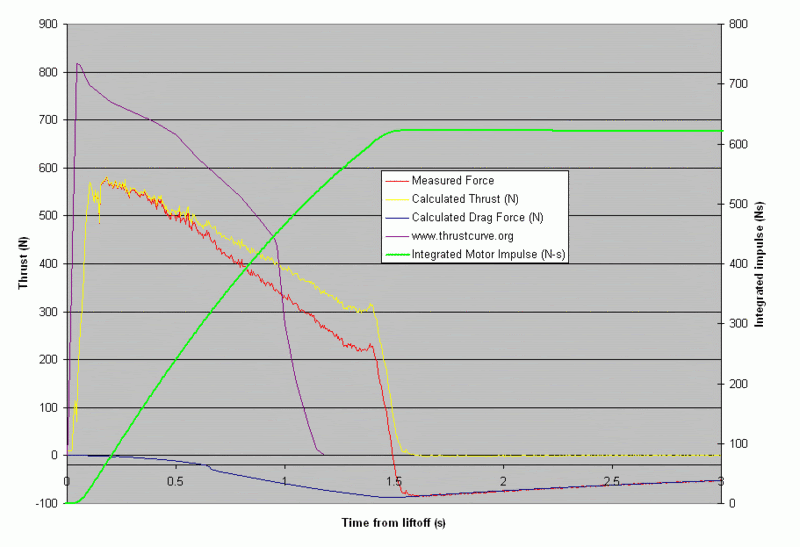
For reference, I also plotted the I600 thrust curve from thrustcurve.org. I think AT made a propellant adjustment or something, because this motor was significantly slower than spec. It's really more like an I400, which was great for this altitude shot. Two summers ago, Chris LaPanse flew a prototype Parrot in his I600 Cirrus Dart shot, and measured the same thing. This thrust curve is built on top of a lot of derived data, but the burn time is straight from the altimeter, and there's a big difference between a 1.2 second burn and a 1.6 second burn. I calculated the integrated impulse to be about 620 Nsec.
Also note that I lost a noticeable amount of impulse bouncing through the launch rails. You can see it in the lateral accel near the top of the page. It makes me wonder whether I should reduce or increase the spacing between the rails and the rocket, and if I'm at the point where additional launch tower length hurts rather than helps. The exit velocity from the tower was 117 mph.
That's the kind of graphic sexy I can relate to. Nice shot Adrian!!!
Very nice!
Where do you get the temperature corrected altitude from?
Edward
Thanks Joe and Ed.
I got the temperature corrected altitude from:
http://psas.pdx.edu/RocketScience/PressureAltitude_Derived.pdf
Correcting for the fact that the ambient temperature was warmer than assumptions used in the standard atmosphere model, the peak altitude was about 16,500 feet. But if I submit this for the record books I'll use the 15965 value based on the standard atmosphere model to be consistent with everyone else.
Joe, what's the radius from the launch pad for our FAA waiver?
2 Nautical Mile radius on the 20,000' AGL waiver and it gets extended to 5 Nautical Mile radius for the "windows" we used Friday and Sunday.
Does that mean that the rocket has to go above 20k to have the 5 nm radius? This is good because I might get to go on another 19 mile hike 🙂
Edward
Hmm.... My rocket landed stayed within the larger high-altitude cylinder, so this could be very close, depending on when the window for Ed's flight was opened. Do you recall the time?
Thanks.
The window opened at 11:30 and was to close at 13:30. I think that they closed it earlier because we wanted to give them the airspace back.
Edward
Darn. If it opened at 11:15 I would have been covered.
I had an interesting boost at Hartsel this weekend.
As noted above, I'm a big fan of Rocksim v 4.0 as it seems to be very accurate, at least for most CTI propellants + most AeroTech loads, with the glaring exception of the BlackJack propellant.
At any rate, I needed 14,003' to exceed the current TRA record by the prerequisite 2%, but the waiver at Hartsel is 14,200'... so the boost had a 197' window of opportunity. I trimmed the rocket for 14,200' with appropriate added mass, field condtions, etc. I got 14,103' on a not-quite-vertical boost, so the sim was on the button.
The bad news is that like Adrian, I landed outside the cylinder 🙁 Today it was dead calm, but I didn't have the time or energy to do it again...
TCO has a 1.5 nautical mile cylinder, with apparently no expansion of the cylinder when the window is activated.
Congratulations, John. Dang, that's some impressive simulation.
Any details for your rocket? Where did it land? Pictures?
Will email you directly, as there was some other stuff that happened on this flight that you will find interesting - I had my first-ever biff with a transmitter. Bottom line is that the reason I didn't feel like flying today was because I walked 16 miles yesterday 😯
you had a good signal before it went over the hill? what happened? Did you get back before the rain? When I drove by on 24 around 3pm looked like most everyone had already gone home.


